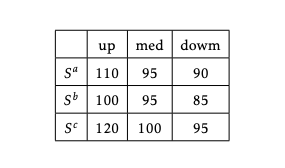Question
Suppose that there are three periods: 0,1 and 2. We consider stocks A,B, and C. None of the three stocks pay any dividend. In period
Suppose that there are three periods: 0,1 and 2. We consider stocks A,B, and C. None of the three stocks pay any dividend. In period 0, the price of stock A is S a 0 = 99.5, the price of stock B is S b 0 = 94, and the price of stock C is S c 0 = 106.5. The one-period risk-free rate in period 0 is denoted by r0. The period 1, there are three states: up,med, and down. State up occurs with probability 0.4; State med occurs with probability 0.3; State down occurs with probability 0.3. The price of the three stocks in period 1 is given by the following state table:

The one-period risk-free rate in period 1 r1 is 5%. Let C(110) be the price of a European call option on stock A that expires in period 2 with the strike price 110. Let P(110) be the price of European put option on stock A that expires in period 2 with the strike price 110.
(a) Solve for r0
(b) Calculate C(110) - P(110)
up sa 110 sb 100 s 120 med 95 95 100 dowm 90 85 95 up sa 110 sb 100 s 120 med 95 95 100 dowm 90 85 95Step by Step Solution
There are 3 Steps involved in it
Step: 1

Get Instant Access to Expert-Tailored Solutions
See step-by-step solutions with expert insights and AI powered tools for academic success
Step: 2

Step: 3

Ace Your Homework with AI
Get the answers you need in no time with our AI-driven, step-by-step assistance
Get Started


